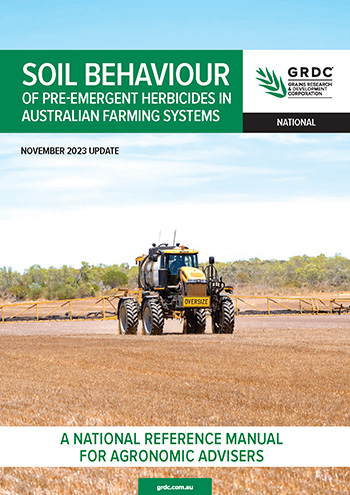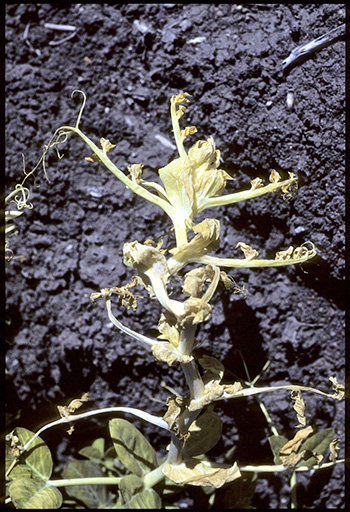Paddock Practices: Updated guide helps reduce risk of pre-emergent herbicide carryover
Paddock Practices: Updated guide helps reduce risk of pre-emergent herbicide carryover
Date: 12 Feb 2024

Key points
- Pre-emergent herbicides have the potential to persist in the soil for longer than desired if conditions do not favour breakdown.
- For herbicides that are inherently slow to break down, dry summer conditions may see the herbicide carryover well into the next crop.
- Growers are urged to review their previous season’s herbicide selection and consider the number of weeks during spring and summer where the top 0-10cm of soil was moist, as this is the only time when a residual herbicide would have been degrading.
- For all herbicides refer to the label or other information provided by the manufacturer for specific advice.
Pre-emergent residual herbicides are an important weed management tool in Australian cropping systems, as they can be used to control weeds that compete vigorously with growing crops for water and nutrients, as well as weed species that are difficult to control using post-emergent herbicides in-crop.
Western region growers have a wide range of pre-emergent herbicides at their disposal and many have the potential to persist in the soil for longer than desired if conditions do not favour breakdown. Safe and effective use of these products requires a sound understanding of their chemical characteristics and the factors that could lead to herbicide carryover causing losses in subsequent crops.
Herbicide persistence factors
The amount of time a residual herbicide persists in the soil at effective levels can be highly variable. The starting dosage in the soil is a key factor. For some herbicides, pre-incorporation losses can occur due to chemical volatility, degradation via sunlight, the incorporation method used, binding to stubble or direct absorption into green leaf material if weeds are present.
Once in the soil, the way a herbicide interacts with moisture, temperature, soil pH and organic matter can affect its persistence.
However, for almost all herbicides, soil microbes are the primary pathway for chemical breakdown. Abundant soil microbe populations require a food source of organic matter, along with warmth and moisture. As a result, microbe populations are usually highest near the soil surface.
If the top ten centimetres of the soil dries out, as often happens over summer, microbe numbers will fall and very little herbicide breakdown will occur until the soil is wet again. For herbicides that are inherently slow to break down, dry summer conditions may see the herbicide carryover well into the next crop.
Managing the risks in Western Australia
In many areas of the WA grain belt, organic carbon content is relatively low which, when combined with limited rainfall and long periods of dry soils, increases the risk of herbicide carryover. Growers are strongly urged to review their previous season’s herbicide selection and consider the number of weeks during spring and summer where the top 0-10cm of soil was moist, as this is the only time when a residual herbicide would have been degrading. Extra caution is recommended on soils with an organic carbon less than 0.5% and/or a cation exchange capacity of less than 2.
Use product knowledge to anticipate herbicide carryover

While the persistence of all pre-emergent herbicides needs to be managed carefully, some products deserve particular attention:
- Herbicides with high soil mobility, such as Group 2 Sulfonylureas (SUs) and Imidazolines (IMIs), as well as Group 4 Pyridines, may move deeper in the soil profile with rainfall after application, especially on lighter soils. When herbicide moves below the area of greatest microbial activity degradation rates can be extremely slow, resulting in extended carryover at depth.
- In addition, Imidazolines tend to have greater soil persistence on acidic soils, while several of the Sulfonylureas persist longer on alkaline soils.
- Of the more recently introduced products, Bixlozone (Group 13, Overwatch®) and Fomesafen (Group 14, Reflex®) have demonstrated extended persistence under conditions unfavourable for breakdown. Both of these herbicides are slow to degrade in the soil, and growers need to ensure there have been extended periods of moisture in the topsoil over the warmer months, before planting sensitive crops into previously treated paddocks.
For all herbicides refer to the label or other information provided by the manufacturer for specific advice.
To help promote awareness of these issues, GRDC has worked with Independent Consultants Australia Network (ICAN) to update the grower and adviser reference manual Soil behaviour of pre-emergent herbicides in Australian farming systems.
The updated publication and its companion guide Understanding post-emergent herbicide weed control in Australian farming systems are both available via the GRDC website. (See Useful resources below.)
Maximising the value of pre-emergent herbicides
Pre-emergent herbicides can be a very useful part of an integrated weed management strategy, with benefits that include:
- Alternate modes of action to many post-emergent herbicides, which helps to delay resistance and minimise the impact where it has occurred.
- Reduced early competition from weeds, providing subsequent benefits for yield.
- Potential to pre-emptively control weed patches, especially where previous weed outbreaks have been GPS-logged to allow for targeted application.
- Useful control of weed species where there are limited in-crop control options.
Using the GRDC’s updated guide to understand the properties and risks associated with different pre-emergent chemistries will help growers make more effective herbicide investments and minimise carry-over risk to crops.
It is also important to remember that pre-emergent herbicides are only one of the tools needed for a year-round integrated weed management strategy. They have negligible impact on the weed seed bank and need to be integrated with tactics such as in-season spraying and harvest weed seed control (HWSC) to minimise weed seedbank and herbicide resistance risks in a profitable cropping system.
More information
Mark Congreve, Independent Consultants Australia Network
mark@icanrural.com.au
Georgia Megirian, GRDC Crop Protection Manager West
georgia.megirian@grdc.com.au
Useful resources
Soil behaviour of pre-emergent herbicides in Australian farming systems
GRDC Reference Manual
Understanding post-emergent herbicide weed control in Australian farming systems
GRDC Reference Manual
Pre-Emergent Herbicides - Part 1: Solubility & Binding
GRDC Video
GRDC: Pre-Emergent Herbicides - Part 2: Incorporation by Sowing
GRDC Video
WeedSmart Big 6 – integrated weed management program
This GRDC Paddock Practices article was produced in collaboration with Independent Consultants Australia Network as part of the GRDC investment ‘Understanding herbicide behaviour workshops’.
GRDC Project Code: ICN1811-001SAX, ICN2307-001SAX,
